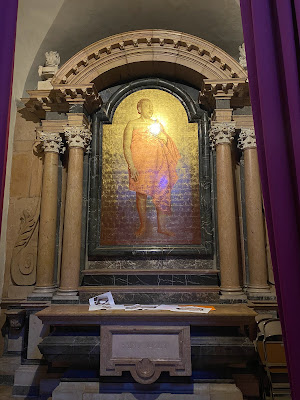I recently revisited the Resistance Museum with a friend of mine and refreshed myself on the basic history of WWII. Though I had a time crunch, I got to see and read some of the things that I hadn't yet seen given that we also were on a tight schedule when we went together as a class.
I had the opportunity to learn more about the important people in the history of France, such as Klaus Barbie and obviously the Soviet leader Joseph Stalin.
Barbie, in charge of the Gestapo, sent Jews to concentration camps, tortured French Jews, and yet somehow was able to avoid conviction during the Nuremberg Trials. He is also known as the "Butcher of Lyon". As for Stalin, as we all know, helped defeat and conquer Nazi Germany in WWII.
There are so many notable things during the span of WWII in France. One that sticks out to me the most that I wanted to learn most about was Vichy, France. I did some further research and found an article with one of the subheadings asking if Vichy was in fact a fascist regime. I have had my share of being around someone who I would say is particularly fascist, so I thought I would state what was written in the article and give my thoughts. “It doesn’t act like a fascist regime because traditionally elites have to give way, and in authoritarianism they retain power. But all the foreign Jews were put into camps, they cracked down on dissent, and it was in some ways increasingly a police state” -Smithsonian. With that said, they are not fascist because they do in fact give some leeway to others actions, thoughts, and ideas.
There is so much to read in the museum, sure, but listening to the short videos of what people had to live through and their personal experiences makes me feel like we are destroying the barrier between the past and the present and coming to terms that these are real people that did in fact live through something that seems so very unfathomable.
There was one particular clip where the woman, as a child, was told to never talk about Petain. Though he as a person was talked about a lot in her home, they never mentioned the name. It just became the 'he who shall not be named' before that term was a common term in today's society due to the Harry Potter series. She mentions that at one point during the school day, the teacher said that she needs to behave and that [the photo of] Philippe Petain was watching her. After being told this, she snapped back basically saying that the fact that Petain is watching means absolutely nothing to her. It's pretty easy to infer that she (a child) along with so many other children and their parents had never liked Petain.
If anyone were to remember absolutely nothing, one takeaway from WWII is to understand that Jews were treated tortured, sent to concentration camps and died whether or not they were in the camps. With that said, if Jewish individuals can't follow their religion and are murdered due to their personal beliefs, imagine what it would be like to outwardly say that you did not fit the norms of sexual orientation, gender identity, and sexuality.



















